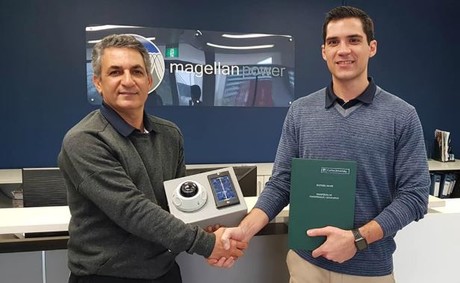Predicting cloud movement to improve solar generation

Curtin University student Mojtaba Saleh recently teamed up with Magellan Power on a PhD project that helps mitigate the effect of passing clouds on solar generation. The PhD project saw Magellan Power create a sky imaging product called the ‘Sky Eye’ which utilises the latest imagery and predictive algorithms, together with machine learning software, to ‘see’ incoming weather.
Masoud Abshar, Magellan Power Managing Director, said the project arose from the need to protect the power grid. “Solar energy is very popular in Australia, and its installation is rapidly increasing. However, the erratic nature of solar generation can cause problems for power grids.
“When clouds cover the sun, the amount of electricity generated by solar power drops suddenly, causing the power grid to compensate for the loss. This loss may not be significant for a large, strong grid but it can be for a small, weaker grid. The loss of solar generation may be too sharp for the grid to cope with, causing the grid to shut down.”
Magellan and Saleh created the Magellan Sky Eye Solar Smoother, which solves the problem of reliability by ‘smoothing’ the photovoltaic power supply. Using real-time information from a sky camera to predict cloud movement for periods of 12 minutes ahead, it calculates the moment cloud shadow will impact the solar panels. It then commands the solar inverter to reduce solar generation in a controlled manner, allowing the grid generator to ramp up and take the load again.
Abshar explained that Horizon Power was the first utility to respond to the problem, mandating that all new solar installations using its grid be equipped with technology to smooth the effects of passing clouds. Horizon Power held a competition to see who could design a solution, and Magellan won but turned to Curtin University for help.
“While Magellan devised the overarching concept for the technology, we needed someone to undertake a significant volume of software development for the project. We needed an expert to calculate factors such as image processing, how to accurately detect clouds, how to determine cloud speed and direction, and so on. We approached Curtin University to assist us, and together chose a PhD student to work with: Mojtaba Saleh,” Abshar said.
He encouraged further partnerships between industry and universities, describing the company’s collaboration with Curtin University as “a win-win situation”. Magellan has a new product and revenue stream, and Saleh has his PhD and a full-time job as part of the Magellan Power team.
Originally published here.
Agreement unites clean energy providers
Wind and water energy come together as Aula Energy signs a long-term power purchase agreement...
Alta project makes existing diesel trains electric
Alta Battery Technology's BET system has demonstrated that practical, scalable rail...
TagEnergy to build a BESS at Golden Plains Wind Farm
Australia’s largest wind farm will soon have a battery energy storage system (BESS).










